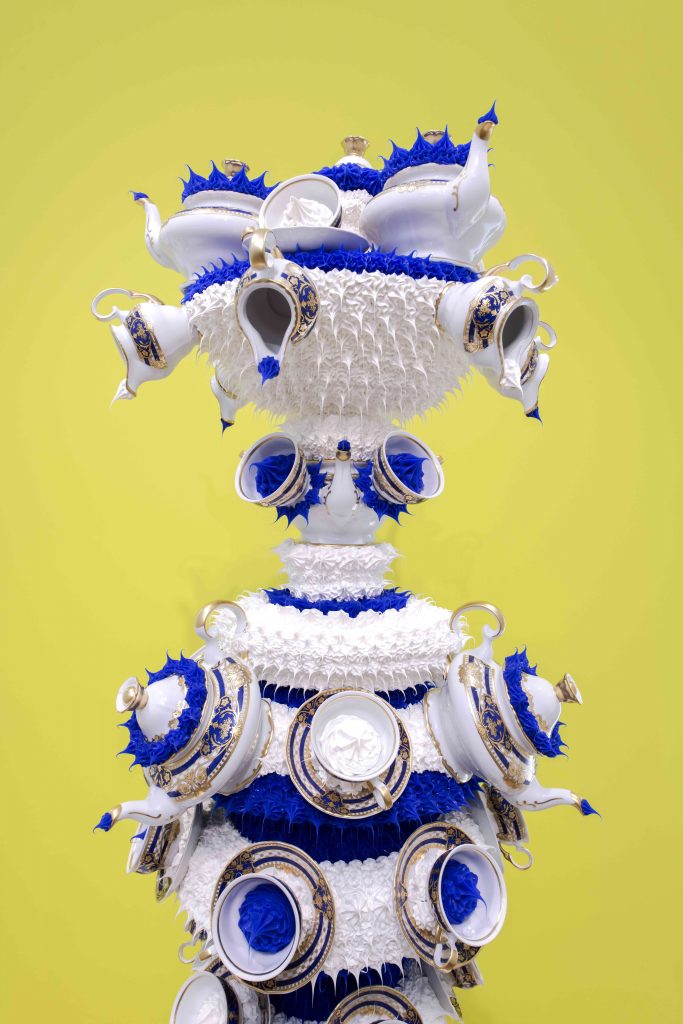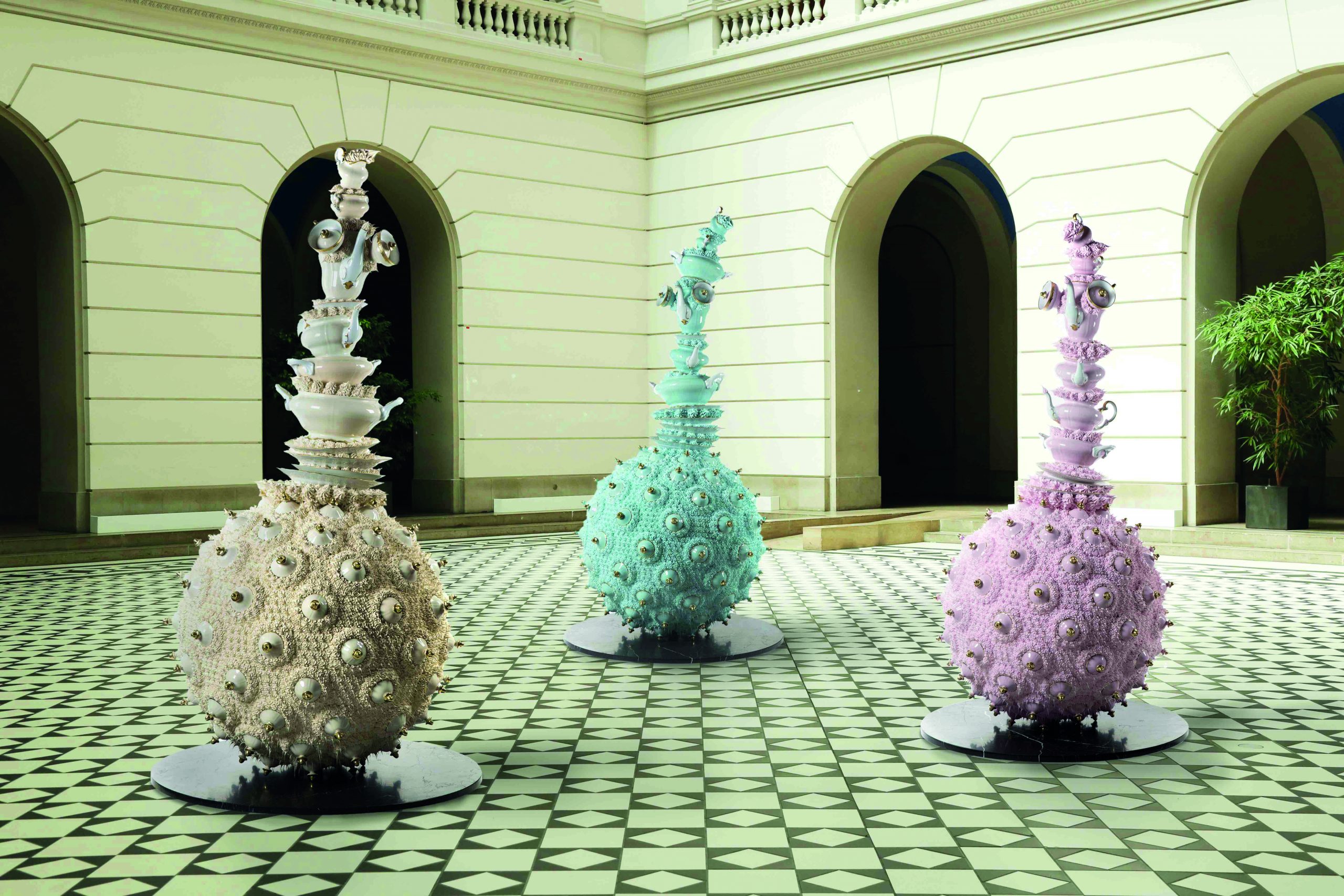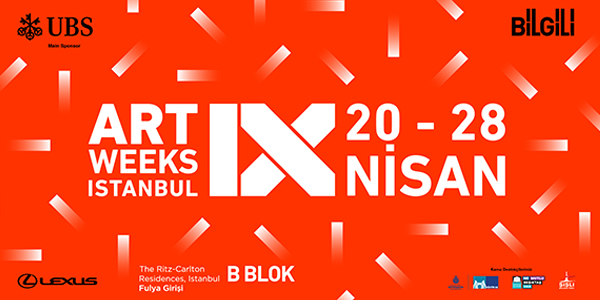Berlin-based artist Anke Eilergerhard’s first solo exhibition in Turkey, “Resilience” showcases more than 30 of her new and recent works including sculptures, wall-reliefs, and screen printings. The exhibition, which hosts a series of interesting sculptures produced by the artist using a special silicone material and porcelain, can be seen at Anna Laudel until January 14th.
In an exclusive interview, Anke Eilergerhard talks about her artistic process and COVID-19’s impact on the art world…
-
Your sculptures stimulate not only sight, but also the senses of touch, taste and smell. For over three decades, the motif of the “Layer Cake” has played a prominent role in your oeuvre. Since 2004, you have been focusing on the sculptural form of the swirl of ‘whipped cream,’ and your trademark is the ‘icing on the cake’. What were your ideals, inspirations & motivations when you created your signature sculptures? In which ways does the ‘stimulation of all senses’ enhance the experience of art?
Basically, I ask these three questions about my art: Is it autonomous, is it expressive, is it unique? I try to stimulate the audience by associating apparently familiar objects and key stimuli. A work of art is only brought to life by the viewer. The dialogue creates a sensual and intellectual experience.
However, I do not want to give instructions on how to read my work. The artistic intention should primarily be communicated through the work itself. Anyone can immerse themselves in their own way, and with their own potentials.
The basic shape, surface structure, color and title are materials. They all have the same status in the development process. Abstract, often reduced basic forms such as spheres, hemispheres and radii, which are staggered, and the surface structure, the color, describe the emotional moment and the title… all of these create the emotion of a body. The abstract sculpture becomes a figuration. Neither color nor shape comes first, everything comes simultaneously.
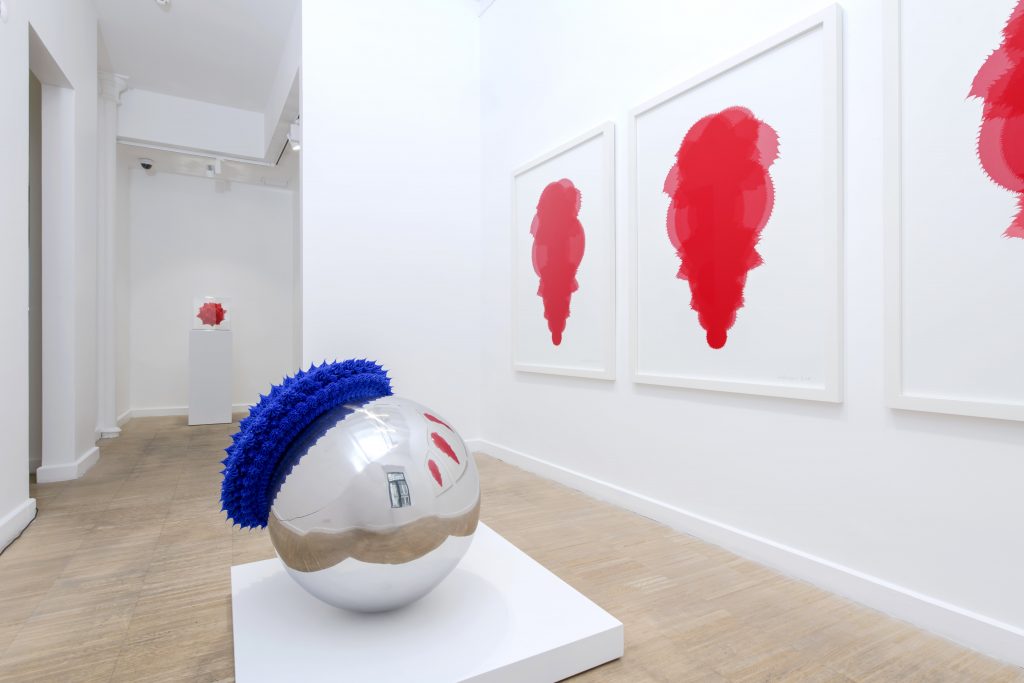
Union of the Seemingly Incompatible
-
We’d like to hear about your unconventional technique. You use silicone as your material. Can you briefly describe your technique and choice of material?
For me, whipped cream is the perfect sculptural shape. There is something cosmic about it. It reflects the longing for paradise. From this I developed my special artistic technique. Like a confectioner, I manually sculpt the whipped cream from highly pigmented polyorganosiloxane (silicone) into a sculpture. Polyorganosiloxane, which DIY practitioners and cosmetic surgeons like to use for correcting imperfections in appearance, is for me the perfect art material in addition to its physical properties.
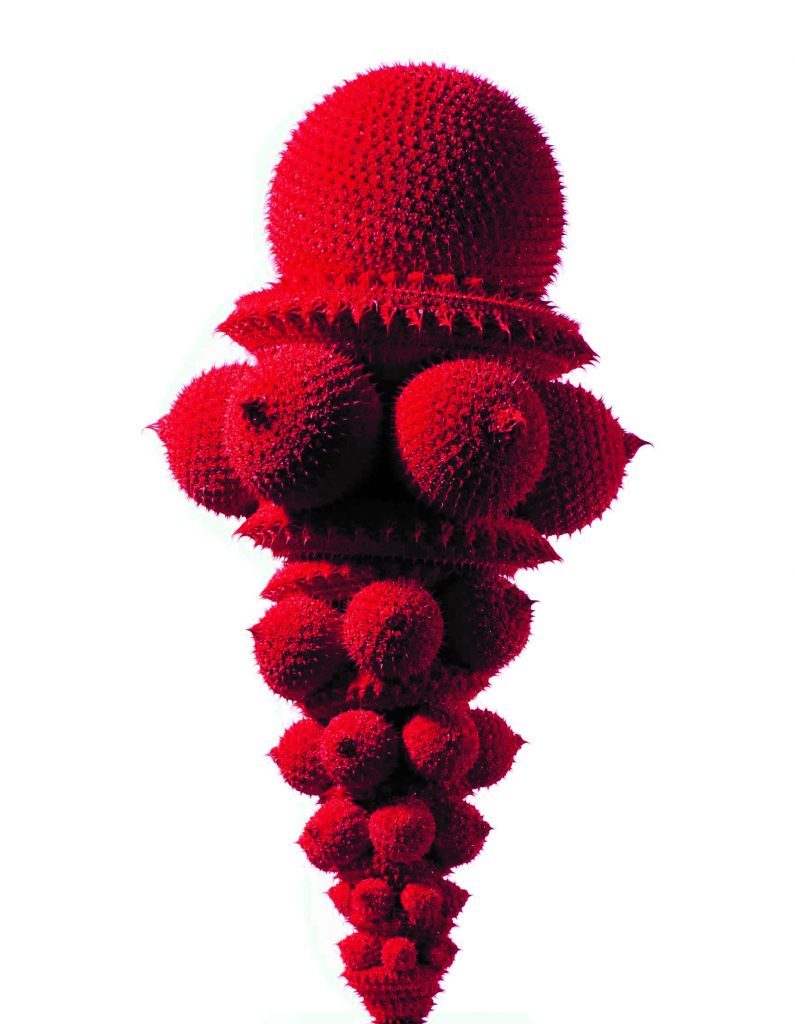
-
You present the known in an unimagined, unknown form. You also apply unusual symmetry and geometry. How does it all come together? When I think about the repetitive process of the silicone caps placed next to and on top of each other; I wonder, do you have a visual in mind beforehand that you’d like to achieve at the end?
My observations and experiences are the basis of all my work. My aim is to make things visible that I cannot put into words and that are still universal. Human sensations such as longing, desire, lust, passion, fear, but also temporality and balance are the focus of my interest. I want to raise awareness of the fragility of our existence.
I am also attracted by the union of the seemingly incompatible, which manifests itself in my sculptures in many ways.
A new sculpture is created in my head long before I sculpt it with my hands. And not just formally, such as the shape, color, and size. But also emotionally. What should it express? How should it stimulate the viewer, where is its ideal place? For weeks, I engage in an inner dialogue with the unborn figure.
Between Orient and Occident
-
Your solo exhibition “Resilience” at Anna Laudel showcases more than 30 of your new and recent works, including sculptures, wall-reliefs, and screen printings. It is your first solo exhibition in Turkey. How do you describe this experience? You’ve visited Istanbul for the exhibition. What are your thoughts on Turkey’s art scene and art viewers?
I get tons of positive comments and posts on social media with very touching feedback. As a result, I spend some time on the smartphone every day, writing responses. This is very stimulating and motivating. Thank you so much to all of you. The exhibition was visited by almost 2,000 art lovers in early November, despite corona restrictions. That honors me a lot and makes me happy.
Through the exhibition at Anna Laudel Istanbul, the discussions with the Turkish artists represented there and, of course, because I am now dealing more with the Turkish art scene overall, I see and experience a very dynamic, creative Turkish art scene with fascinating art, which of course is partly world class. I think the geographic location between Orient and Occident is very inspiring for artists. There is a preference for intense colors, ornament, and poetry.
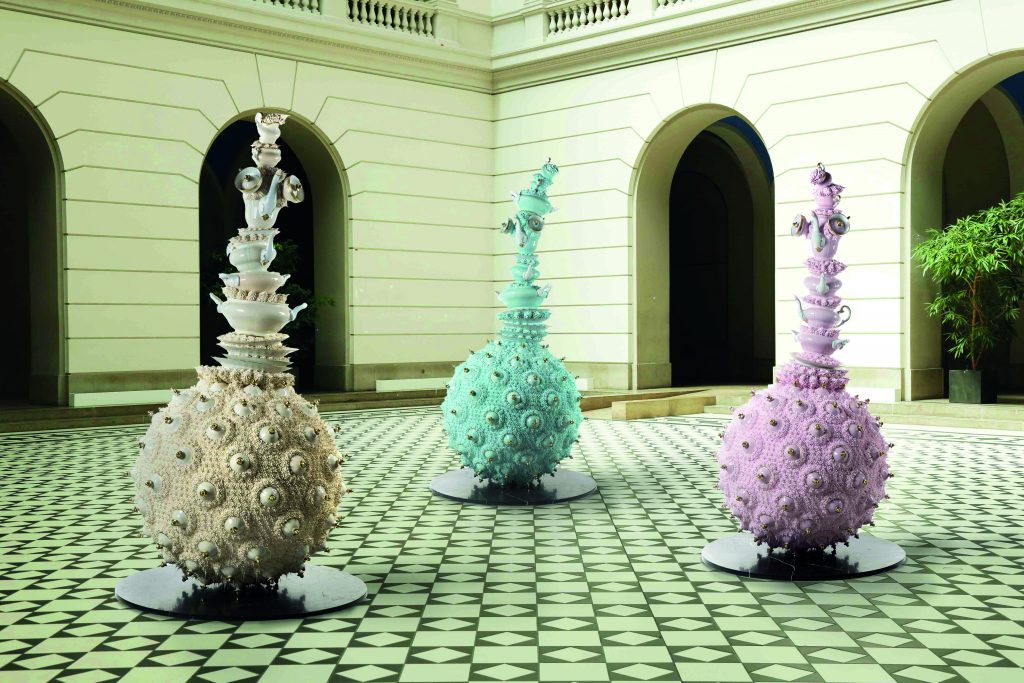
I Love Colors, I Taste Them
-
The use of color is also an important subject for you. Visitors can see dynamic colors but also dreamy pinks and turquoise shades. In your work, color and form merges in some way. Can you tell us about your color palette and their reflections on your artworks?
When I was little, my grandma often took me to a cafe to eat cake. There I not only marveled at the floral wallpapers and the fascinating shapes and colors of the cakes on display that were lit up as if on a stage, but I also enjoyed my grandmother’s brief bliss. Presumably, a palette of shapes, colors and emotions manifested itself there early on. For me, a cake with whipped cream is a piece of heaven on earth.
I love colors. I taste them. Just as one doesn’t like to eat the same thing every day, I always prefer new colors. Colors are an expression of emotion. There are people who have a sense of color that can be compared with a musician’s perfect pitch.
-
We can say the whole world has stepped into a new era with this pandemic. How did the coronavirus outbreak affect you and your art practice? Has it changed your themes, colors? Has it affected your preferred medium or presentation methods? We’ve seen online exhibitions, fairs present online viewing rooms. How do you think digitalization will change the art world? Do you think ‘online’ can provide the same experience as in-person experience?
For a long time I have been on the trail of questions that are even more urgent, due to the digital reception of art during the current crisis. How physical, how real must works of art be? What does “real” mean in terms of the digital reality of distribution and reception? What does the digital reception of art do to art and to its recipients? Is it a completely different situation when the viewer experiences art in a space especially designed for this purpose, together with others, at an exhibition opening or a visit to a museum? What if he is viewing an image of an artwork on a 5 x 5 cm screen during a daily social media scroll. Will our perspective change? Will art change? What will remain and what will become lost?
-
How do you describe your psychological state during this viral pandemic and quarantine period? What were the main questions/topics on your mind? 2021’s coming, in which ways do you think it’ll be different? What are your expectations, hopes for 2021?
The pandemic has a strong impact on everything. It is like a sieve through which, perhaps, less important things are simply filtered out. It makes you tougher, more creative, sadder, more adult, more serious. But it also shows how important it is to persevere. The artists are particularly trained in this. Resilience is the order of the day.
Democratization of Artistic Taste
-
The global art scene has also been affected by the pandemic. Art fairs were cancelled, art galleries closed; some artists have started selling work directly through their social media accounts. There are concerns that, blue chip galleries aside, small and medium scale galleries will have hard time surviving. Do you think artists and their ways of finding and connecting to collectors and art viewers will change? If yes, in what way? What will the new, post-coronavirus art scene look like?
The pandemic is like a natural disaster that is already destroying so much. Many sacrifices are made. For some artists and galleries, it has surely come at a very bad time, and not everyone will survive the crisis. But there is hope. Nature shows us how, after a fire, new life can arise on scorched earth. Maybe with even more beautiful flowers. May that also apply to the art scene.
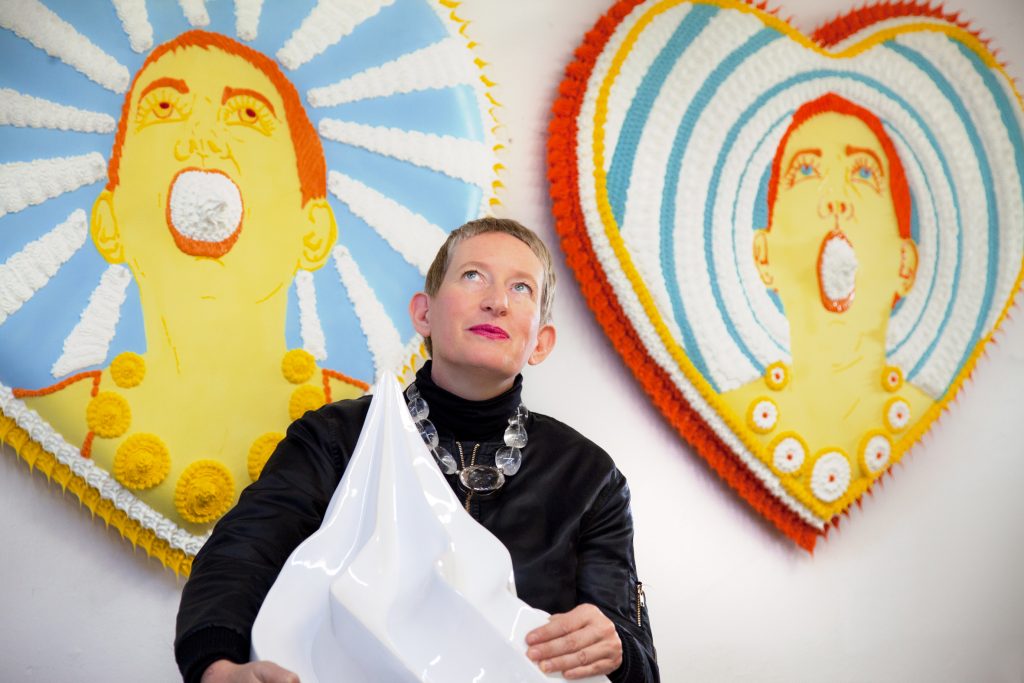
-
The Frieze Sculpture opened in Regent’s Park in 2020. People prefer outdoor displays during the pandemic. Do you think outdoor art exhibitions and artworks in public spaces will be more popular? Also in your case, how will it affect artists that create large-scale artworks or installations?
Christo and Jean-Claude have set standards when it comes to outdoor art. Why is their art so powerful? Because even at the concept stage, the work was conceived, in a way, to be in a relationship, interaction and in unity with the environment and its reception. It seems impossible and nonsensical to squeeze a “Valley Curtain” inside a museum. On the other hand, I believe that art cannot simply be moved outside. Often, it lacks the shelter of the museum or gallery. It is then simply in an inappropriate place. Or else, the work of art has to be laboriously proofed for wind, weather, vandalism and theft, which often contradicts the intended effect and leads to a material battle. It is at least possible, here and there, to create selfie spots that attract the public. This, as a result of the power of going viral, can make previously unattractive places more attractive and stimulate tourism. Perhaps this will go hand in hand with future ways of receiving and valuing art. In a way, it is the democratization of artistic taste.
-
Can you tell us about your next project that you’re working on right now?
I keep asking myself whether and how I can make sculptures for outdoor use. Right now, I’m even busier with this question because the curators of the Bad RagARTz Sculpture Triennial in Switzerland have invited me to take part in the 2021 triennial with an open-air sculpture. I’m curious to find out what the viewers will see of me there.
